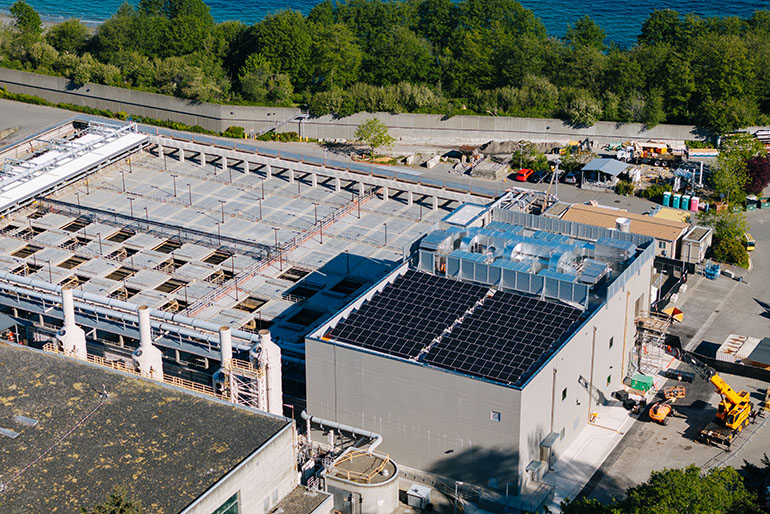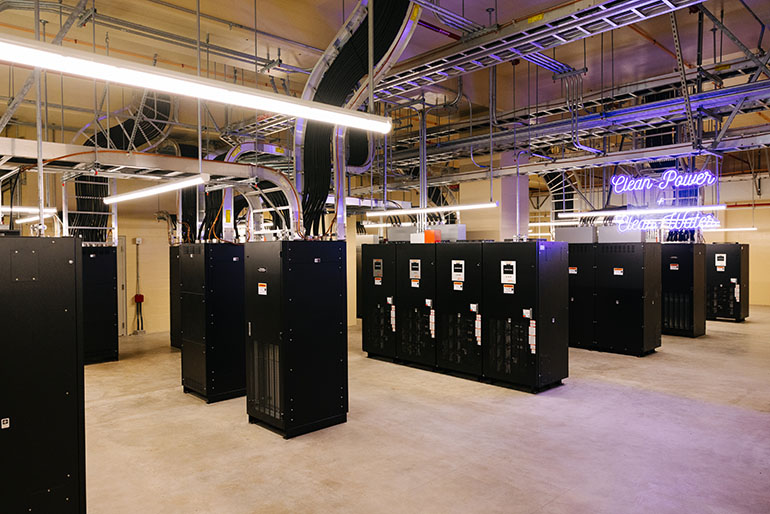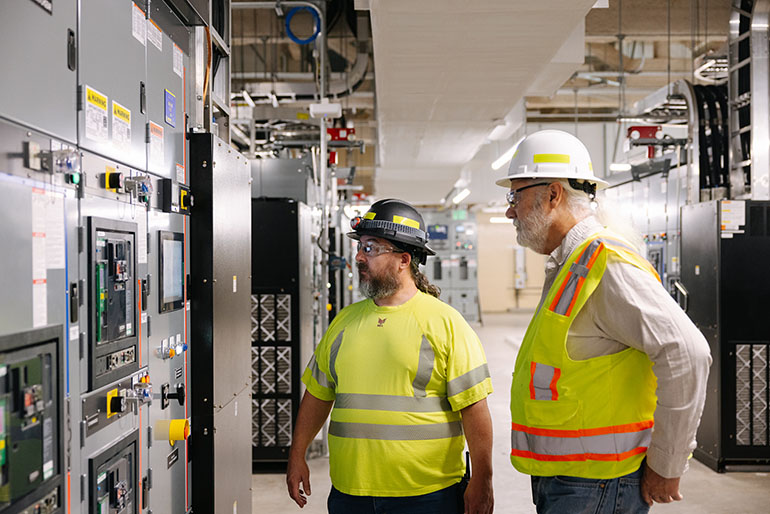‘We still brace ourselves, but now we can breathe easier’: Operators at West Point Treatment Plant credit new battery system for delivering reliable power during its first year
Summary
June 24, 2025: The first-of-its-kind battery system at King County’s West Point Treatment Plant proved effective during its first year, keeping critical pumps operating during 78 power disruptions. There were 15 instances when pumps at the state’s largest treatment plant were powered exclusively by the 16.8-megawatt battery system.
News
Operators at King County’s West Point Treatment Plant credit the new onsite battery system for providing reliable power during its first year of service, ensuring critical pumps operated during 78 power disruptions.
Engineers estimate that 15 of those power disruptions were severe enough to potentially cause an emergency bypass of untreated wastewater into Puget Sound had the onsite batteries not been activated in June 2024. Pumps at the state’s largest treatment plant were powered exclusively by the 16.8-megawatt battery system during each of those disruptions.
King County Executive Shannon Braddock praised the West Point employees who successfully built and are now operating this first-of-its-kind battery power system.
“What began as an award-winning engineering marvel is now an operational success,” said Executive Braddock. “The onsite battery system we installed at West Point Treatment Plant is delivering exactly what we promised: providing reliable power that protects Puget Sound, even when our region experiences catastrophic weather events.”


"Protecting our ancestral waters from untreated wastewater is fundamental to a healthy and thriving ecosystem. Tribal members — as well as the greater community — should be able to access the Salish Sea without having to worry if it's contaminated," said Leonard Forsman, Chairman of the Suquamish Tribe. "It's a relief to learn that the improvements made at the West Point Treatment Plant are working, and we appreciate King County’s investment in the infrastructure needed to prevent future spills."
The Power Quality Facility – which has received multiple engineering awards – proved to be reliable during its first wet weather season, when the plant is most vulnerable to power disruptions. The batteries provided consistent power each time voltage from the inbound electrical grid dipped below a determined threshold.
“The onsite battery system provides us a peace of mind and allows operators to focus on other response efforts when the plant experiences power disruptions,” said Clinton Fisher, acting Instrumentation and Electrical Supervisor for the Wastewater Treatment Division’s West Section. “I had my doubts at first, but after seeing how it’s worked — and what it’s helped us avoid — I’m a believer.”
West Point experienced a dramatic increase in power disruptions compared to five years ago. During one extreme weather event, the powerful “bomb cyclone” windstorm in November 2024, the plant experienced 28 voltage sags, with the onsite batteries needing to be utilized seven times to keep critical pumps running. Another windstorm in late February caused 11 more voltage sags and two full-power outages, with the onsite batteries stepping in four times — twice each for voltage sags and outages.
“Our trained operators take pride in our work, protecting public health and the environment for our community,” said Sean Kehoe, Operations Supervisor at West Point Treatment Plant. “Power outages used to be completely out of our control, until a year ago. When it’s windy and the lights flicker, we still brace ourselves, but now we can breathe easier knowing that the Power Quality Facility will help keep our pumps running.”


The King County Wastewater Treatment Division completed the ambitious capital improvement project just 3½ years after former King County Executive Dow Constantine signed an emergency declaration. Within two years, crews erected the 24,000-square-foot Power Quality Facility that houses more than 2,000 batteries along with 140 solar panels that provide clean power for lighting, heating, ventilation, and air conditioning that keeps the batteries cool.
“This is one of the most successful local infrastructure projects I’ve seen in a long time and shows what government can do when we act with urgency and creativity,” said King County Councilmember and Chair of the Regional Water Quality Committee Claudia Balducci. “Protecting our water — for the health of our people, wildlife, and future — is one of our most important responsibilities and I am thrilled that we have this new capacity to fulfill that responsibility.”
“A storm system may be out of our control, but being ready to respond to a storm isn’t,” said King County Councilmember Jorge L. Jorge L. Barón. “In its first year, the Power Quality Improvement Project at West Point has responded to unexpected power interruptions and proven its ability to keep power supplies consistent and our waters clean. This is a benefit to the entire Puget Sound region, and all the animals and people who call it home.”
“The Power Quality Facility exemplifies the positive impact we can make to clean water by investing in our regional wastewater infrastructure,” said Kamuron Gurol, Director of the King County Wastewater Treatment Division. “This project is one of dozens underway across our service area that are modernizing our wastewater system to be resilient to climate impacts and meet our communities’ needs for decades to come.”
The Power Quality Improvement Project has received multiple industry awards, most recently from the American Council of Engineering Companies.
It is among dozens of capital projects that have made West Point Treatment Plant safer, more reliable, and more resilient in recent years. The Wastewater Treatment Division in 2022 completed seismic upgrades and is now replacing raw sewage pumps, which have been operating nearly nonstop since the 1960s.
“The reliable onsite battery system is the latest in a series of successful projects that have made the Puget Sound region’s largest treatment plant safer, more reliable, and more resilient to climate impacts,” said John Taylor, Director of the Department of Natural Resources and Parks. “Our workforce has consistently demonstrated the ingenuity needed to modernize critical infrastructure.”
Multimedia
- VIDEO: Battery backup passes first-year test
- VIDEO: A-roll footage of interviews
- VIDEO: B-roll footage of battery power system
- PHOTO GALLERY: Battery power system at West Point Treatment Plant
Resources
- Power quality improvement at West Point Treatment Plant
- King County team delivers on Executive Constantine’s emergency declaration to provide West Point Treatment Plant with high-quality power
Quotes
What began as an award-winning engineering marvel is now an operational success. The onsite battery system we installed at West Point Treatment Plant is delivering exactly what we promised: providing reliable power that protects Puget Sound, even when our region experiences catastrophic weather events.
Protecting our ancestral waters from untreated wastewater is fundamental to a healthy and thriving ecosystem. Tribal members — as well as the greater community — should be able to access the Salish Sea without having to worry if it's contaminated. It's a relief to learn that the improvements made at the West Point Treatment Plant are working, and we appreciate King County’s investment in the infrastructure needed to prevent future spills.
A storm system may be out of our control, but being ready to respond to a storm isn’t. In its first year, the Power Quality Improvement Project at West Point has responded to unexpected power interruptions and proven its ability to keep power supplies consistent and our waters clean. This is a benefit to the entire Puget Sound region, and all the animals and people who call it home.
This is one of the most successful local infrastructure projects I’ve seen in a long time and shows what government can do when we act with urgency and creativity. Protecting our water — for the health of our people, wildlife, and future—is one of our most important responsibilities and I am thrilled that we have this new capacity to fulfill that responsibility.
The onsite battery system provides us a peace of mind and allows operators to focus on other response efforts when the plant experiences power disruptions. I had my doubts at first, but after seeing how it’s worked — and what it’s helped us avoid — I’m a believer.
Our trained operators take pride in our work, protecting public health and the environment for our community. Power outages used to be completely out of our control, until a year ago. When it’s windy and the lights flicker, we still brace ourselves, but now we can breathe easier knowing that the Power Quality Facility will help keep our pumps running.
The reliable onsite battery system is the latest in a series of successful projects that have made the Puget Sound region’s largest treatment plant safer, more reliable, and more resilient to climate impacts. Our workforce has consistently demonstrated the ingenuity needed to modernize critical infrastructure.
The Power Quality Facility exemplifies the positive impact we can make to clean water by investing in our regional wastewater infrastructure. This project is one of dozens underway across our service area that are modernizing our wastewater system to be resilient to climate impacts and meet our communities’ needs for decades to come.
Contact
Akiko Oda, Wastewater Treatment Division, 206-263-4190

 Translate
Translate